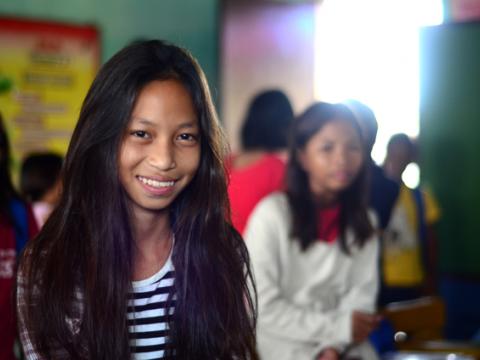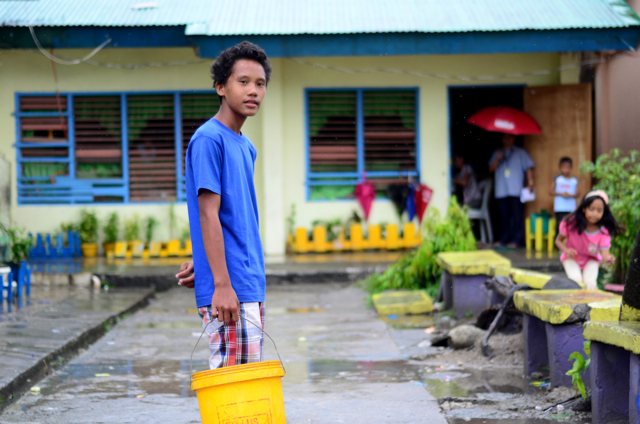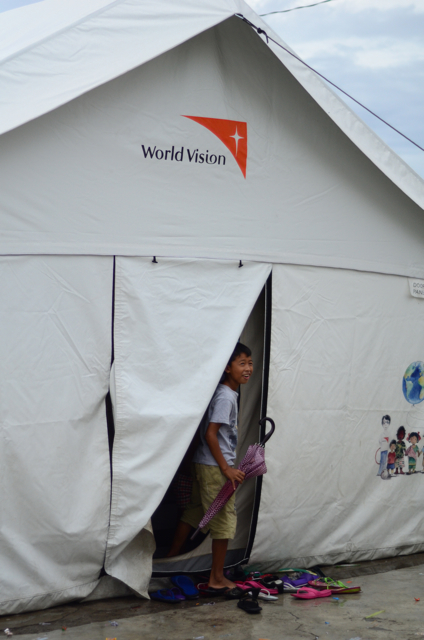Restoring Water and Hope in Damaged Schools

By Mark Nonkes, World Vision Regional Communications
It was a job no one wanted.
But John Mark was the tallest in his class and at 13, his teachers must have figured he could shoulder the load.
Every day, John Mark grabbed two pails hidden in the corner of his classroom and embarked on a journey.
He needed to get to the nearest water pump – a 10-minute journey away and wait in queue. Once it was his turn, he filled the pails and then ferried them back to the school. It was a journey her repeated over and over – there are 42 children in his classroom and many children in younger grades needed his help too.
John Mark isn’t the complaining type though. While the other children in his class learned multiplication, to spell words in English or the feats within Filipino history, John Mark ensured children had something to quench their thirst during the nine hour school day. John Mark brought water to flush the toilets, many dilapidated, and for children to wash their hands – to ensure his classmates remained healthy.
“I was just happy we were all okay,” John Mark says.
Typhoon Haiyan hit John Mark’s school hard. The steel sheets of the school’s roof were ripped off by the strong winds, books and teaching material were soaked, two classrooms were completely destroyed and the school’s water system, along with washrooms, lay in ruins.
“We saw a lot of damage when we came to the school after the storm,” says Angel, one of John Mark’s classmates.
Nearly every child in the primary school was affected – many homes now lay in a haphazard hill of debris.
“We were hiding under the bed, my mom, dad and my brother. The wind was so strong, the rain was so heavy, our roof was ripped off, trees fell on our house. It sounded so strong,” John Mark remembers. “We were thinking a lot of people must have died.”
After the storm, many families whose homes were completely destroyed descended upon the school – taking cover inside the roofless walls during the first few nights after the storm.
“We had no food at that time. The rice got wet by the water, there was nothing to eat,” says Laura Hagan, a mother of two children attending the school.
Responding to the needs, World Vision’s relief team arrived and provided food aid. Later a string of other items – shelter kits, hygiene kits and other materials were provided to families whose children attended the school.
“After a few days, the men started helping each other rebuild,” explains Joblyn, another Grade 6 student.
For the children, World Vision set up two Child Friendly Spaces and offered a series of activities to address children’s emotional needs and to help restore a sense of normalcy.
For children like Angel, it was a break from the traumatic reality they found themselves in.
“We played games, made art, had role plays and listened to stories. When I was in the Child Friendly Space, I felt happy,” says Angel, the oldest of three children, whose home was damaged during the storm.
When school reopened in January, the tents used as Child Friendly Spaces were transformed into temporary classrooms.
And while children were elated that classes restarted, for John Mark school meant a series of new tasks.
“The rest of us were afraid to cross the road to get water,” says Angel, referring to the highway in front of the school. “The area to get water is quite far, the highway we have to cross it busy.”
Inside the classrooms, children dreaded going to the washroom – the toilet was broken.
“I felt sad and shy when I felt the need to use the comfort room. I just held it. But that meant I wasn’t comfortable and couldn’t focus on the school work.”
World Vision’s reconstruction team is currently working in the school to repair the washrooms.
“One of the most basic needs in an emergency is for clean water and basic hygiene systems to prevent disease outbreaks. We aim to restore water and sanitation systems for 25 locations,” says Ronnie Santos, a water and sanitation coordinator working on the Typhoon Haiyan response.
A few weeks ago, the school’s water system was restored, ending John Mark’s daily trek.
Now, John Mark is back in his class – doing exactly what a boy in Grade 6 should be doing – learning.

